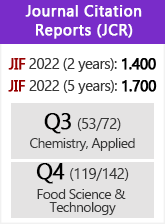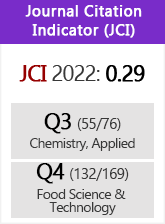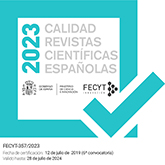Evaluation of greek-style black table olives in salt varying brines
DOI:
https://doi.org/10.3989/gya.2005.v56.i2.117Keywords:
Black olives, Chemico-physical properties, Feeding preferences, Fermentation, Microbiological analysisAbstract
hree fermentation processes with black table-olives were tested. Olives were placed in: a) 16 %(w/v) concentration of NaCl, (traditional treatment), b) a buffer of CH3COOH (0.05M) and Ca(OH)2, (0.025M) without any NaCl and initial pH 4.7, and c) a buffer of CH3COOH (0.05M) and Ca(OH)2 (0.025M) containing 12.8 % (w/v) NaCl, and pH 4.3. Isolation, identification and enumeration of predominant microorganisms from fruits and brines sampled during the fermentation periods as well as color, intensity, texture and sensory evaluation tests of the final products were conducted. The third fermentation process, (c), yielded a product with low salt content no presence of spoilage microflora or other alterations during the fermentation period, with significantly better final texture and color, and higher acceptability among the consumers (P<0.05) compared to the other two. Potential use of a low-salt modification of the traditional black-table olives' fermentation process was proposed.
Downloads
Download data is not yet available.
Downloads
Published
2005-06-30
How to Cite
1.
Kanavouras A, Gazouli M, Tzouvelekis Leonidas L, Petrakis C. Evaluation of greek-style black table olives in salt varying brines. Grasas aceites [Internet]. 2005Jun.30 [cited 2024Apr.18];56(2):106-15. Available from: https://grasasyaceites.revistas.csic.es/index.php/grasasyaceites/article/view/117
Issue
Section
Research
License
Copyright (c) 2005 Consejo Superior de Investigaciones Científicas (CSIC)

This work is licensed under a Creative Commons Attribution 4.0 International License.
© CSIC. Manuscripts published in both the printed and online versions of this Journal are the property of Consejo Superior de Investigaciones Científicas, and quoting this source is a requirement for any partial or full reproduction.All contents of this electronic edition, except where otherwise noted, are distributed under a “Creative Commons Attribution 4.0 International” (CC BY 4.0) License. You may read here the basic information and the legal text of the license. The indication of the CC BY 4.0 License must be expressly stated in this way when necessary.
Self-archiving in repositories, personal webpages or similar, of any version other than the published by the Editor, is not allowed.
















